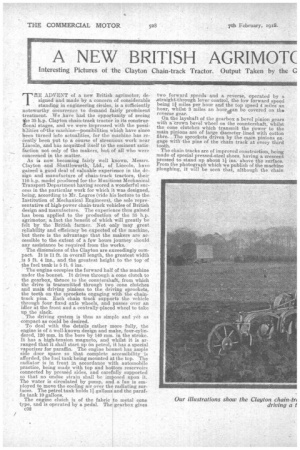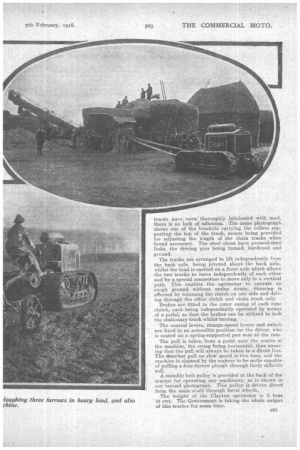A NEW BRITISH AGRIMOR
Page 10

Page 11

If you've noticed an error in this article please click here to report it so we can fix it.
Interesting Pictures of the Clayton Chain-track Tractor. Output Taken by the G
TPIE ADVENT of a new British agrimotor, de. signed and made by a concern of considerable standing in engineering circles, is a sufficiently noteworthy occurrence to demand fairly prominent treatment. We have had the opportunity of seeing the 35 h.p. Clayton chain-track tractor in its constructional stages, and we were impressed with the possiClities •ofkthe machine—possibilities which have since been turned into actualities, for the machine has recently been put to a course of strenuous work near Lincoln, and has acquitted itself to the eminent satisfaction not only of the makers, but of all who were concerned in the matter.
As is now becoming fairly well known, Messrs. Clayton and Shuttleworths Ltd., of Lincoln, have gained a good deal of valuable experience in the, design and manufacture of chain-track tractors, their 110 h.p. model produced for the Munitions Mechanical Transport Department having scored a wonderful success in the particular work for which it was designed, being, according to Mr. Legros (vide his lecture to the Institution of Mechanical Engineers), the sole -representative of high-power chain-track vehicles of British design and manufacture. The experience thus gained has been applied to the production of the 35 h.p. agrimotor, a fact the benefit of which will greatly be felt by the British farmer. Not only may great reliability and efficiency be expected of the machine, but there is the advantage that the makers are accessible to the extent of a few hours journey should any assistance be required from the works.
The dimensions of the Clayton are exceedingly compact. It is 11 ft. in overall length, the greatest width , is 5 ft. 4 ins., and the greatest height to the top of the fuel tank is 5 ft. 6 ins. • The engine occupies the forward half of the machine under the bonnet. It drives through a cone clutch to the gearbox, thence to the countershaft, from which the drive is transmitted through two cone clutches and main driving pillions to the driving sprockets, the teeth on the sprockets engaging with the chaintrack pins. Each chain track supports the vehicle through four fixed axle wheels, and passes over an idler at the front and a centrally-placed wheel to take up the slack. . The driving system is thus as simple and yet as compact as could be desired. To deal with the details rather more fully, the engine is of a well-known design and make, four-cylindered, 120 mm. in the bore by 140 mm. in the stroke. It has a high-tension magneto, and whilst it is arranged that it shall start up on petrol, it has a special vaporizer for paraffin. The engine bonnet has ample side door space so that complete accessibility is afforded, the fuel tank being mounted at the top. The• radiator is in front in accordance with automobile practice, being made with top and bottom reservoirs connected by pressed sides, and carefully supported so that no undue strain shall be imposed upon it. The water is circulated by pump, and a fan is employed to move the cooling air over the radiating surfaces. The petrol tank holds 1:'s gallons and the paraffin tank 10gallons. The engine clutch is of the fabric to metal cone type. and is operated by a pedal. The gearbox gives o32 two forward speeds and a reverse, operated by a .straight-through lever control, the low forward speed being l miles per hour and the top speed 4 miles an hour, whilst 3 miles an hourigan be covered on the reverse gear. On the laysliaft of the gearbox a bevel pinion gears with a–crown bevel wheel on the counters-haft, whilst the cone clutches which transmit the power to the main pinions are of large diameter lined with cotton fibre. The sprockets driven by the main pinions engage with the pins of the chain track at every third tooth.
The chain tracks are of improved construction, being made of special pressed-steel shoes, having a crescent pressed to stand up about 11 ins. above the surface. From the photograph which we publish of the machine bloughing, it will be seen that, although the chain tracks .have been thoroughlylubricated with mud, there is no lack of adhesion. The same photograph shows one of the brackets carrying the rollers supporting the top of the track, means being provided for adjusting the length of the chain tracks when found necessary. The steel shoes have pressed-steel links, the driving pins being turned, hardened, and ground.
The tracks are arranged to lift independently from the back 'axle, being pivoted about the back axle,
whilst the load is carried on a front axle Which allows the two tracks to move independently of each other and by a special connection to move only in a vertical path. This enables; the agrimotor to operate on rough ground without undue .strain. Steering is effected by releasing the clutch on one side and driving through the other clutch and chain track only.
Brakes are fitted to the outer casing of each cone clutch, each being independently operated by means of a pedal, so that the brakes can be utilized to lock the stationary track whilst turning.
The control levers, change-speed levers and switch are fixed in an accessible position for the driver, who is seated on a spring-supported pan seat at the rear.
The pull is taken from a point near the centre of the machine, the swing being horizontal, thus ensuring that the pull will always be taken in a direct line. The drawbar pull on slaw speed is two tons, and the machine is claimed by the makers to be quite capable of pulling a four-furrow plough through fairly difficult soil.
A suitable belt pulley is provided at the back of the tractor for operating any machinery, as is shawn in our second photograph. This pulley is driven direct from the main shaft through bevel wheels.
The weight of the Clayton agrimotor is 2 tons 16 cwt. The Government is taking the whole output of this tractor fox some time.






















